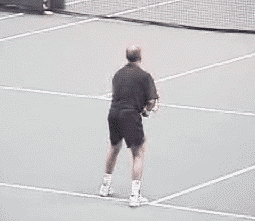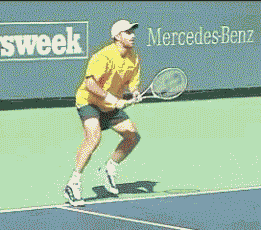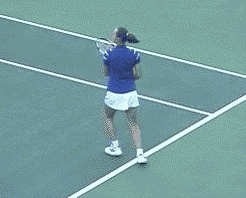
How to counter specialist styles
One of the more intriguing aspects of tennis is the various games styles that are available to players. Even though tennis has become much more of an all-court game, all players still favour a particular style of play. No longer can a player rely purely on one style of play and be poor in other areas of the court, however the modern player will build a game style around their strengths. This means that every good competitor should be clear in their mind about their own game style and how their strengths will hurt their opponents. Equally, important players need to know how to counter the various styles of play they will compete against.
In this article I have outlined the basic game styles available and share some ideas on how to counteract the different styles of play. Remember that each player is unique and within these different game styles there will be specific strengths or weaknesses you can only identify once you have played against or watched a player carefully.
The serve and volleyer
The serve and volleyer expects many free points and wants the opponent to get a complex about their return of serve. He thinks if he can put away some good returns and passing shots early in the match, the opponent will panic and start to try for better and better returns and passes. When a serve and volleyer serves well, it is easy to feel that they are unbreakable.
1. Try to make as many returns off the first serve as you can, even if it gives him an easy volley. Giving the serve-volleyer a high volume of balls to put away pays off later in the match, when the pressure is high.
2. Attack the second serve, not specifically with pace, but by moving up the court to get the ball back faster and rushing the volleyer. It is then very important to make him volley for a second time or hit an overhead. Do not go for rash passes off good volleys – make him play. Again, the pay-off comes later in the match!
3. Be patient. Do not panic but sit and wait for the loss of focus – the game that has a double fault, the missed volley or many service faults. It often happens after one or two great service games.
4. Try to hit as many returns to the feet as possible, not neglecting the return down the middle.
 The good returner
The good returner
This player makes a high volume of returns and hits the ball well in front, rushing the server. He wants to create the following feelings:
1. Server getting nervous, not knowing where to serve to get an easy point.
1. Serve into the body more. It is harder to step into the ball when it is coming at you. Do not look for the easy point, expect a return. Do not rush the first shot or volley – make him play his second shot of the rally. They rely on quick points. This player is a tough customer, so he does not panic unless you show that you are prepared to make him play longer points. Run hard and work hard to give him a high volume of second shots.
2. Keep your 1st serve percentage high by mixing in a lot of ¾ speed serves into your repertoire. Also use a mixture of spins to prevent the class returner from settling into a routine knowing what to expect.
3. Try to mess up his range by mixing up the serve and volley game. In other words, sometimes wait for the return, then go in and take a few chances hitting a few bigger second serves.
4. Prevent giving him easy games on his own service. This allows him to concentrate exclusively on his strong point – breaking you with good returns.
 The clay-court specialist
The clay-court specialist
This player will wear you down until you lose reason and patience and start slashing at balls looking for a quick winner, or attacking the net without rushing and unbalancing him first.
If you are not a similar player you know you have to attack well – therefore most important is your frame of mind. Accept that:
1. You will be passed.
2. You will watch some top-spin lobs land behind you.
4. You need to look forward to the moment when he actually becomes erratic and gives you a few freebies.
Method of attack
1. Your own serve is your biggest weapon in this fight – use it well to keep them off balance. Approximately 60% three-quarter pace first serves, concentrating on placement (including to the body) so that your first-serve percentage remains high. 40% hard serves so he can never settle down to one pace and you can get a few free points.
2. Serve and volley some of the time especially at 30-40, 40-30 and advantage points
3. The two big shots in your attack arsenal after the serve are the second shot off the return and the return of serve. If the second shot is a volley, volley behind the player a lot and cut off volleys short (not drop volleys but turning away volleys, cross court).
4. When the second shot is off a shorter return you must attack the ball to take command of the point and create chances for the 'cut in'.
5. When you attack the net, do not forget one of the most neglected approach shots: deep down the middle to jam them up and take away a clay-courter’s lifeblood – passes made on the run creating angles. Play the down-the-middle shot to force him to hit a backhand, e.g. if he regularly runs round the backhand (to hit inside-out forehands) then your 'down the middle shot' might actually be further over to his backhand side.
Return of serve
1. Make a high volume of returns off first serves using height. Do not be too proud to stand well back to achieve this. As you get used to his serve, you can step up into the court to rush him more.
Warning - Just because you hit a good second shot or return does not mean that you keep control of the point. Often the opponent will counter with good length and spin. In this case, settle down and play the point looking for an opportunity to attack. Do not press to take control – play for it.

The net rusher
A net rusher wants to rush until you panic. The player often approaches the net on a 'bluff' and relies on the pressure of you having to pass him so often that it wears you down.
1. Watch the ball and play your shots as you normally would. Ignore the odd, amazing dive volley! Once he knows you are not rushed to pass him and do not mind him winning a fair share of the points when he has hit a good approach shot, this player has little left.
2. Make the opponents play a high volume of volleys and overheads.
3. Take any chance you get to go in. Rarely do 'chip and charge merchants' hit good passing shots themselves.
 The big hitter
The big hitter
This player tries to blast you off the court and overpowers you. He will usually start well and is a good front runner. Awesome when playing well.
1. Hustle and use height. It is imperative that this player is made to hit 3 or 4 big shots to win the point as often as possible.
2. Swing early and meet his big shots in front so you can use his pace against him. Also if you can get to the net at times, then forcing him to hit passing shots and to force the pace may cause him to overhit and lose control. Your state of mind needs to prepare you to ignore his great shots, work hard and not be intimidated; be convinced he will run out of big shots if he has to hit enough of them. Once he begins to miss and hesitate you are in control.
 The deceptive player
The deceptive player
This player wants to break your rhythm and, more importantly, prevent you from establishing any rhythm at all. He will mix up and rush you by deceptive play, because he holds the ball on the strings well. He mixes pace and, varying his serves, can generate surprising pace when moving forward on the ball, and time a return off a big serve. A very difficult customer.
1. Apart from possibly the serve, they have few gears to step up the pace.
2. Their game is based on timing, with fewer margins for error when they move the ball to create angles. They are prone to making mistakes in batches.
3. Play back to the opponent, e.g. if he hits a cross-court angle, hit the ball back cross court in order to reduce the angles, unless you feel confident of hitting a winning shot down the line.
4. Get under the ball well to keep a good length because then it is harder for them to move the ball around. It also leads to important approach opportunities. Be low, alert and agile at the net because if you start to read the passes from this player, he is dead because he cannot beat you with pace. Stay low, to give them a problem – the heavy ball!
5. Your state of mind. Do not be concerned if you feel disjointed or unbalanced by this player at times – you cannot avoid it. He will cut you up with little cuts and you need to thrust a sword through him before you bleed to death. Get him to feel over-powered by hitting big shots, volleys, serves and overheads when you get a chance. Don’t get cute and try to outmanoeuvre him when you can kill the ball.
6. If you play the same way as this player – play the percentages more.
Within the above styles of player, you may also need to take into account the following characteristics:
The sneak-in specialist
Don’t watch for him coming in. Watch the ball and realize that when in trouble sometimes go for the big shot, and off the backhand slice, go down the line because this is the most difficult place from which to hit an effective volley.
The all-rounder
Very tall players and very quick players
Hit directly at tall players when they are at the net. The lob is not wasted because if they hang back sometimes it is easier to get the ball at their feet.
Very quick players recover quickly and can reach shots that are played away from them relatively easily. Therefore, a good tactic is often to place the ball behind them in the spot they have just come from, thus wrong-footing the player.
by David Sammel
Pictures used in this article are courtesy of TennisOne

